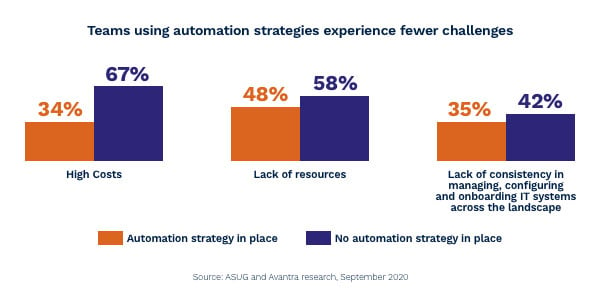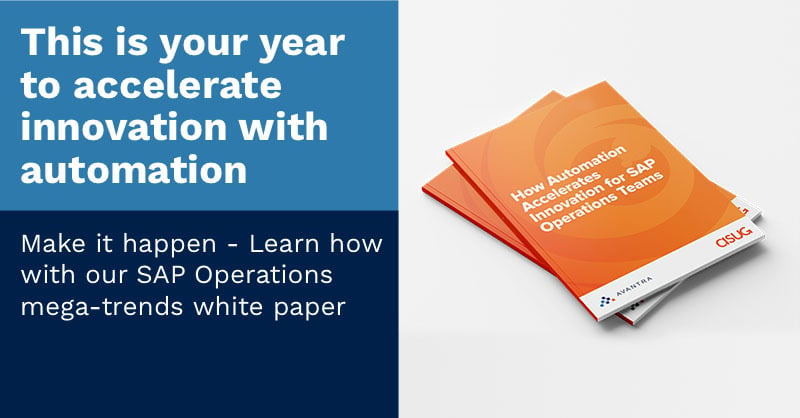4 min read
SAP Operations Teams Analysis: Here’s What We Learned
By: Emily Tippins on Feb 22, 2021 6:05:05 PM

Last year, Avantra approached ASUG with an idea. What if we could expose the places where innovation was happening within SAP Operations teams?
ASUG (Americas' SAP Users' Group) had insight into SAP customers and innovation from previous studies. So, it was a natural fit to collaborate on this exciting new research. Together, we could truly understand what role automation plays in innovation.
This study throws new light specifically on the attitudes and approaches of the people responsible for managing these complex SAP technology landscapes - the SAP Operations team. For the first time, we are able to share critical insights into the human factors at play. Let me explain why this data will make you want to kick those innovation barriers to the curb...
Barriers to innovation for SAP Operations teams
A fascinating bi-product of this exercise was uncovering the barriers that inhibit SAP Operations teams from innovating. We didn’t intentionally set out with this agenda. But, we discovered a stark difference between the attitudes of the innovators and the executors.
Incidentally, In this study, we refer to those who spend most of their time innovating as innovators, while the executors are those who spend more time executing current strategies.
83% of the participants that were identified as innovators are automating their business processes, compared with only 72% of the executors. This additional automation may be setting up these SAP customers with the right conditions to innovate more often, as we also saw more innovators working on customer experience projects (67% versus 42%) and introducing new products or services (67% versus 39%).
SAP Operations teams want to innovate
Finding a balance between innovation and execution is a very real battle for SAP customers. ASUG has tracked this in their annual ASUG Pulse of the SAP Customer study since 2018. Last year, 70% of ASUG members surveyed said their organizations spend most of their time executing current strategies, while only 30% spend time planning for the future. And yet innovation does matter to the people involved in making these organizations a success. In fact, 51% of employees said this affects their job satisfaction and 44% said it determines how long they stay in a job.
Grab the ASUG research paper today, so you can plan for the future >>
This research is brought to you by Avantra, in collaboration with ASUG.
Linking innovation to SAP automation
The idea of automating processes your operations team are quite happy managing manually may initially seem counter-productive. But, when put another way, you could ask: who doesn’t want you to innovate? Your competitors… that’s who.
This study presents an opportunity for organizations to get a competitive ‘leg up’ through the efficiency and capacity that automation brings with it. With this advantage, SAP customers can deliver more innovative technology projects for the business. Rather than taking the SAP professionals out of the equation, use their skills at their best. Allow them to zero in on the actionable insights provided by AIOps.
SAP customers may not be deeply familiar with AIOps yet. But our study shows that this doesn’t undermine the desire to realize its potential.
What operations teams want from SAP AIOPs
The top feature that SAP customers told us they want to see in SAP AIOps is monitoring and analytics, followed closely by upgrades and patching, which are two of the biggest pain points in SAP system management. Almost half of respondents would also like to see performance management included.
If you’re at the beginning of your AIOps journey, this study tells us that you’re not alone. Most of your peers are in a similar situation.
Only 9% are currently using AIOps, but another 26% plan to make it part of their approach in the future. Another 38% are interested in learning more about it.
One respondent noted, “We are looking to use more automated approaches within IT. With this move to automation, we have transitioned many employees into other roles that create more value for the company.”
SAP Operations teams face less challenges when adopting AIOps
The impact of barriers associated with innovation (high costs, lack of resource, and lack of standardization across the SAP landscape) are felt less by teams using automation. Organizations with an automation strategy in place are much less likely to experience IT Operations challenges related to SAP projects than organizations without automation in place.

Even those focussed solely on execution, can still achieve drastic benefits from automation. AIOps can be the tool that cuts through the complexity of SAP systems and leads them from a constant cycle of keeping the lights on to delivering more value to the organization. But the SAP Operations teams that are planning for the future more than the execution of business as usual projects are the winners.
For me, the key takeaway from this study is that the only way to truly cut through the complexity of SAP systems is through AIOps. As a tool, AIOps can lead IT Operations teams away from a constant cycle of keeping the lights on towards innovation and future planning that delivers exceptional value to the organization.
Download the ASUG & Avantra Automation Innovation white paper >>
Related Posts
New Avantra 20.5 is here, what’s new?
We are thrilled to announce the release of version 20.5 of Avantra providing the next step on the...
What is SAP cyber security?
Recently, we discussed the various security measures SAP takes to mitigate and prevent security...
Why is SAP security monitoring important?
SAP applications drive the most business critical processes in companies around the globe. It will...





